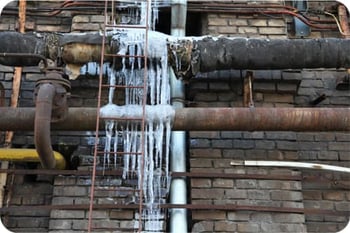
In recent years, various regions across the globe have witnessed extreme weather conditions, such as unprecedented cold months and heat waves. As the seasons change, so do the challenges that facilities face. Regardless of the industry or the size of your business, preparing for the winter and summer months is essential to prevent operation disruptions and costly structural damage.
In this blog, we'll discuss the significance of seasonal maintenance and practical steps to ensure the well-being and safety of your workplace.
Ensuring Workplace Safety
Employee health and safety should always be your number one priority. Consistent and seasonal maintenance protects against potential hazards from extreme weather conditions, ensuring a safe and secure working environment. In addition to protecting your employees, proactive seasonal maintenance is a way to protect your physical assets. A well-maintained facility is less prone to damage, protecting your investment and preventing costly repairs.
 Preventive maintenance also minimizes the chances of interruptions, allowing for a seamless workflow even in the face of adverse weather conditions. From extreme cold causing equipment malfunctions to scorching heat affecting employee productivity, a well-prepared facility can weather these challenges, ensuring business continuity.
Preventive maintenance also minimizes the chances of interruptions, allowing for a seamless workflow even in the face of adverse weather conditions. From extreme cold causing equipment malfunctions to scorching heat affecting employee productivity, a well-prepared facility can weather these challenges, ensuring business continuity.
Strategies for Year-Round Comfort
Safeguarding your facility is not only a seasonal endeavor but an ongoing commitment. Taking a proactive approach to facility management involves implementing year-round measures that shield against the weather challenges each season may bring.
Yearly evaluations can help ensure that your building is ready for all seasons.
Preparing your building for every season is possible with annual evaluations.
- Inspect the physical building structure for any damage or areas that need attention.
- Perform routine HVAC maintenance (i.e., clean air vents, use high-quality air filters and replace them often, examine ductwork, and get professional annual tune-ups).
- Examine the insulation to ensure the levels are sufficient and fit the structure’s needs.
- Weatherstrip all windows and doors to prevent drafts and ensure proper air ventilation.
- Calibrate thermometers regularly and consider installing programmable thermostats to maintain appropriate temperatures for occupants.
- Implement climate zoning systems for areas with poor ventilation to prevent HVAC systems from overworking and overcompensating.
Winter Preparedness
The winter months can be a dangerous time with icy roads and freezing powerlines. The plummeting temperatures can induce stress on the building's components, from the foundation to the roof to the pipes, creating vulnerabilities that can affect operations.
Here are some ways to prep for the colder months:
 Winterize HVAC systems.
Winterize HVAC systems.- Prepare plumbing.
- Inspect water runoffs to prevent flooding.
- Install freeze-prevent monitoring systems and leak sensors.
- Appraise the condition of the roof.
- Alter or turn off irrigation and sprinkler systems.
- Spread salt on icy or snowy parking lots to prevent slipping hazards.
- Trim trees that are close to buildings and windows.
Summer Preparedness
During the hotter months, when some regions can reach 120 degrees, severe heat can cause detrimental damage to buildings, from material degradation, roof deterioration, and HVAC strain to fire risk and window impairment.
Here are some ways to prepare for summer:
- Ensure windows are adequate.
- Install light-blocking curtains and blinds to retain cooler temperatures.
- Install energy-efficient lighting and windows.
- Survey refrigeration systems and establish suitable temperatures.
- Clean and restore A/C coils.
Benefits of Preparing Early
Beyond the immediate advantages of shielding your physical assets and ensuring the safety of your valued employees, early preparation for weather challenges is a strategic investment that yields substantial cost savings. By identifying and addressing potential issues in advance, you not only safeguard the structural integrity of your facilities but also protect against the financial toll of unforeseen damages. This forward-thinking practice also contributes to the prolonged life and optimal functionality of your equipment, sparing you from the expenses associated with premature replacements and unexpected breakdowns.
In summary, early preparation is not just a preventive measure but a fiscally responsible strategy that promotes long-term stability and operational resiliency.
Weather-Ready Workplaces
 Seasonal maintenance and weather preparations extend beyond a routine checklist — they’re a necessity for the sustained success of your business and the safety of your employees. By protecting your facility and preparing for extreme weather conditions, you're helping create a work environment where employees feel safe and protected.
Seasonal maintenance and weather preparations extend beyond a routine checklist — they’re a necessity for the sustained success of your business and the safety of your employees. By protecting your facility and preparing for extreme weather conditions, you're helping create a work environment where employees feel safe and protected.
While proactive measures significantly reduce the likelihood of unexpected challenges, weather remains unpredictable and can cause considerable damage. Having an emergency preparedness plan in place can add a layer of protection against unforeseen events.
Seasonal maintenance and a robust emergency preparedness plan combine to create a holistic approach to business sustainability that highlights the importance of employee safety and operational endurability, protecting your business against the unpredictable nature of the elements.
-
Is your facility equipped for rigorous winters or severe heatwaves? Flagship can assist in preparing your business for unforeseen weather conditions before it becomes too late.
Visit our emergency preparedness page for more information.





Leave a Comment